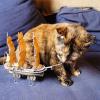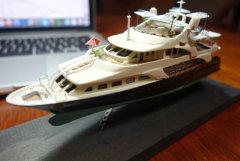MORE HANDBOOKS ARE ON THEIR WAY! We will let you know when they get here.
×
-
Posts
366 -
Joined
-
Last visited
Reputation Activity
-
 steamschooner got a reaction from John Allen in SS Maaninka by Moxis - FINISHED - 1/25 scale - Lake steamer
steamschooner got a reaction from John Allen in SS Maaninka by Moxis - FINISHED - 1/25 scale - Lake steamer
moxis, Do overs are the norm around my shipyard, sometimes more than once. Railings look super!
-
 steamschooner got a reaction from mtaylor in SS Maaninka by Moxis - FINISHED - 1/25 scale - Lake steamer
steamschooner got a reaction from mtaylor in SS Maaninka by Moxis - FINISHED - 1/25 scale - Lake steamer
moxis, Do overs are the norm around my shipyard, sometimes more than once. Railings look super!
-
 steamschooner reacted to Moxis in SS Maaninka by Moxis - FINISHED - 1/25 scale - Lake steamer
steamschooner reacted to Moxis in SS Maaninka by Moxis - FINISHED - 1/25 scale - Lake steamer
Yes, ratlines is the second difficult task with which I have struggled many many times. Luckily this ship doesn`t have them. But this is how the railings look now. Still not quite perfect but much better than earlier. I won`t change them any more.
-
 steamschooner reacted to kayakerlarry in Howard W Middleton 1883 by kayakerlarry - FINISHED - scale 1:96 - coastal coal schooner
steamschooner reacted to kayakerlarry in Howard W Middleton 1883 by kayakerlarry - FINISHED - scale 1:96 - coastal coal schooner
Well after 10 long months, 394 ratlines and 1200 (exactly...) clove hitches I'm finally done with this phase. Quarter board carving hasn't turned out so well so will now move onto finishing running rigging and then who knows.
-
 steamschooner got a reaction from popeye the sailor in Arabia 1856 by Cathead - FINISHED - Scale 1:64 - sidewheel riverboat from the Missouri River, USA
steamschooner got a reaction from popeye the sailor in Arabia 1856 by Cathead - FINISHED - Scale 1:64 - sidewheel riverboat from the Missouri River, USA
Eric, Your hull looks very good, I wonder did they paint the bottoms on these early riverboats or use some sort of tar or pitch mixture?
-
 steamschooner got a reaction from Canute in Arabia 1856 by Cathead - FINISHED - Scale 1:64 - sidewheel riverboat from the Missouri River, USA
steamschooner got a reaction from Canute in Arabia 1856 by Cathead - FINISHED - Scale 1:64 - sidewheel riverboat from the Missouri River, USA
Eric, Your hull looks very good, I wonder did they paint the bottoms on these early riverboats or use some sort of tar or pitch mixture?
-
 steamschooner got a reaction from Cathead in Arabia 1856 by Cathead - FINISHED - Scale 1:64 - sidewheel riverboat from the Missouri River, USA
steamschooner got a reaction from Cathead in Arabia 1856 by Cathead - FINISHED - Scale 1:64 - sidewheel riverboat from the Missouri River, USA
Eric, Your hull looks very good, I wonder did they paint the bottoms on these early riverboats or use some sort of tar or pitch mixture?
-
 steamschooner reacted to Mirabell61 in Eagle of Algier 1753 by Mirabell61 - FINISHED - 1:48 - Chebec - Nils Langemann
steamschooner reacted to Mirabell61 in Eagle of Algier 1753 by Mirabell61 - FINISHED - 1:48 - Chebec - Nils Langemann
Update :
put the 7 guns on the starboard deck, placing them between the gratings, for checking positions (dry fit)
The other 7 guns are in progress. Also some additional decore (sea horses and dolphins)
Nils
the barrels are from RB, I chose 40 mm length instead of 32 mm
hope the space allows enough room for rigging the guns later on...
-
 steamschooner reacted to Cathead in Arabia 1856 by Cathead - FINISHED - Scale 1:64 - sidewheel riverboat from the Missouri River, USA
steamschooner reacted to Cathead in Arabia 1856 by Cathead - FINISHED - Scale 1:64 - sidewheel riverboat from the Missouri River, USA
Watching the winter Olympics has both slowed and helped my work. Slowed, because it's been an evening time sink watching so many events I enjoy. Helped, because I moved into the final parts of hull planking that required more careful shaping and manual gluing, so it gave me something to do while messing with individual planks.
I've been planking from the outside in, and once I got too near the centerline, my normal binder-clip clamps (black, below) wouldn't fit anymore. So I started using reversed and halved clothespins instead, whose angled shapes work quite well as wedges (also below). Their clamping parts aren't doing anything, but wedging them into the narrow gaps between plank and the center bulkhead worked really well, at least for straight areas. For curved areas, I mostly did this manually and watched Olympics. But I was really pleased with this method.
Then I made a frustrating mistake, managing to snap off a big chunk of the curve bow guard extension. It actually wasn't hard to repair, I just cut away most of the bow's curve on both sides, and bend and inserted a new piece that fully swept around that curve. It's not quite as nice as the original because the new joint was harder to hide, but when the model is finished it won't really show. I was still very annoyed with myself because I've been so careful in handling.
So here's the planked hull. Note that in this photo I've begun inserting the extra guard timbers at the stern, but not yet at the bow, to bring them up to the right density. If I had decided to plank over the underside of the guards, I wouldn't have needed to do this, so hadn't until the decision was made. But there's abundant evidence that leaving the guards open underneath is the right approach, so in go the rest of the guards.
As you may be able to tell above, I also used some wood filler to match a few less-than-ideal gaps in planking, mostly in the complicated stern area. Above, I've applied it to the starboard (lower) side but not yet the port (upper side), and haven't yet sanded it down. Below is a closer look at the stern, with one side filled and one side not. In this photo, it has been sanded. It's definitely smoother now but the planking lines still show through. I'm pleased with how this came out overall, though I did struggles to get the run of planking right and could probably have done it better. Those odd extensions at the very stern are on the real thing, I'll come back to that soon when I show the building of the rudder.
And here she is with all the guard timbers installed, right side up with my machinery templates laid out for reference. If you look closely at the starboard wheel area, you'll see a little vertical wooden thing that doesn't resolve well in the photo. That's my rough person for scale, he's about 5'8", shorter than me but about right for the period. The wheel is in about the right vertical place and orientation. The plain white rectangle represents the boilers.
So that's where Arabia stands post-Olympics. Next up, I need to cut way too many short strips of hull planking to fill in the last strake between all the guard timbers, then do any final hull finishing necessary. I'll paint the hull next before proceeding to planking the deck, and also will finish the rudder, though I probably won't install it until the very end to keep if from being knocked off. Then, finally, I'll move toward deck planking.
Thanks as always for following along. Hopefully this starts to get more interesting soon as we turn her right side up and the machinery and superstructure get underway.
-
 steamschooner reacted to Omega1234 in SHADOW by Omega1234 - FINISHED - Scale 1/300 - Luxury 60m Mega Yacht
steamschooner reacted to Omega1234 in SHADOW by Omega1234 - FINISHED - Scale 1/300 - Luxury 60m Mega Yacht
Hi Folks!
It’s been a sad week. Mum’s funeral was held on Monday this week. At 91 years old...a good innings, as they say.
Needless to say, the shipyard was pretty quiet this week; that is, until tonight, in which I was able to do a bit more work, and also take these photos and short videos. Ahem...all I can say after watching them, is that these close up photos and videos show up every bit of dust, inaccuracy and mistake...oh well...
Pls enjoy!
Thanks
Patrick
24769D02-191E-4171-8803-9E9447A38966.MOV
4672163D-5583-4001-AABF-7B63C91761FE.MOV
9628DDD9-31F2-44C4-AF9E-75C3B7674626.MOV
640DE8AE-1623-411B-A1A7-97A6BB52EB78.MOV
71413B7C-049A-4552-B99E-50009B04EE27.MOV
-
 steamschooner reacted to Moxis in SS Maaninka by Moxis - FINISHED - 1/25 scale - Lake steamer
steamschooner reacted to Moxis in SS Maaninka by Moxis - FINISHED - 1/25 scale - Lake steamer
Some time has elapsed since the last update. However it has been busy time at the shipyard. Boat deck has been made by gluing 3 pcs 0,6 mm plywood together on a form. It was much easier and faster to make that the main deck of thin strips.
After that I was consentrating into railings. My first idea was to buy all the stanchions ready, because of the "balls", which are difficult to produce. However no suitable ones were found with correct dimensions, so nothing else remained than make them by myself. And after all about 80 pcs are needed, so they wouldn`t have been cheap as well.
But first I had to make the wooden handrails. They were produced after many trials and errors of 3 pcs 2x6 mm wooden strips which were glued together on a form. This was a bit difficult, because handrails are bending in two directions, and after removed from the form they start to straighten a bit, so the curvature of the form must be tighter that that of the ship`s deck. But as said, after three or four errors I finally was satisfied with the result. Not perfect yet, but I can live with that.
The stanchions were made of common 1,5 mm brass rod, and the wires attached to them out of 0,6 mm copper wire. Wires were soft soldered into stanchions, and "balls" were made of putty mixed of microballons and epoxy. And finally painted white.
Handrails glued together on a form. Difficult shape because bending in two directions.
Handrails in different stages of fabrication.
Stanchions of 1,5 mm brass and 0,6 mm wires soldered together and "balls" made of epoxy/microballons putty.
Railings test fitted before painting.
And glued into ship. Not perfect but I can live with that.
Main deck railings ready.
Seen from front. Next the same thing for upper deck.
-
 steamschooner reacted to AntonyUK in Korean Turtle Ship by AntonyUK - FINISHED - Scale 1/32
steamschooner reacted to AntonyUK in Korean Turtle Ship by AntonyUK - FINISHED - Scale 1/32
Hi.
Well i have finished the Turtle ship.
Thanks to all that contributed to the design and the build.
It was FUN and lots of learning.
Photos...
The crews Head.(Toilet)
Decorations. around the ship..
Holes in the roof for thrusting the lance up into anyone on the roof.
Another view of the roof.
The Bow area.
View of Bow with anchor in place.
The Rudder (Note its not balanced ??)
Pegs in main beams that support the deck.
Stern area with top structure removed.
Mid section with top structure removed.
Close up of the oars for sculling.( interesting method they used. 3 or 4 oars men with one master oars man.)
Another internal view.
Stern view with top structure removed.
Bow anchor.
Anchor winch.
Captains cabin with private Head (toilet) to the side.
That about concludes the build for me...
Thanks for all the likes and wonderful comments.
Regards Antony.
OGH.. the extra photo.. Close up of the oars.
-
 steamschooner reacted to russ in Captain Roy 1948 by russ - FINISHED - 1/48 scale - POB - Biloxi Lugger
steamschooner reacted to russ in Captain Roy 1948 by russ - FINISHED - 1/48 scale - POB - Biloxi Lugger
Deck planking is complete and the deck has been scraped fairly well. I will, look again over the weekend to see if it needs any more scraping.
The last deck plank, outboard and aft on the starboard side, has no glue on it. It went in nicely on the last fitting and I could not raise it again to apply glue to the bottom. Oh well, it is in there to stay regardless.
Russ
-
 steamschooner reacted to Thanasis in Tserniki by Thanasis - FINISHED - vessel from Mytilene Island
steamschooner reacted to Thanasis in Tserniki by Thanasis - FINISHED - vessel from Mytilene Island
Hello all. You might have noticed my absence but I’m still here…
Well, it’s been a long time since a previous presentation work of mine but I’m not notorious for accurate build logs anyway. So I have come to prove myself again …
I started the model one year before accepting the challenge to build a model with open hull.
I didn't work on it regularly, so that's why the lack of many photos, not that I have in my mind to take photos in other case…
I chose to represent a vessel from my place of origin, the Island of Mytilene (Lesbos).
It was a small double ended vessel (Tserniki type) which was used for coastal trading.
It was usually rigged with a half lateen sail or a sacoleva sail (sprit sail).
......
I observed many photos of that vessel from the archives of 3w.naftotopos.gr and I modified an old plan of that hull type.
I built the model following the method plank on bulkheads removing a number of them afterwards from the middle of the hull.
I prepared the false frames by soaking proper pieced of wood, bending them and drying them on the surface of the removed bulkheads.
......
I had to paint the inner of the hull before I plank the deck and keep it covered for the rest of the construction.
......
The grapnel anchor was made by using fishing hooks that were set and glued inside a hole in a plastic rod, while the cleats on the mast were made by modifying some fishing swivels…
The Shackles were made as is shown there
The Belaying pins were made as is shown there
The Sails were made as is shown there
The cargo was made by chopping some twig pencils.
It took me much time to decide about the colors on the model…Painting is always the only stage of my builds that stresses me. Wanting to give a local-origin character in my models, I'm always anxious whether I have chosen the right colors or I have turned it to a clown.
......
Finally the stand was made by a piece of plywood and some wooden rings which were cut in half.
I hope my wife won’t notice the missing curtain hoops...
See the finished model in gallery.
Many thanks
-
 steamschooner got a reaction from popeye the sailor in Arabia 1856 by Cathead - FINISHED - Scale 1:64 - sidewheel riverboat from the Missouri River, USA
steamschooner got a reaction from popeye the sailor in Arabia 1856 by Cathead - FINISHED - Scale 1:64 - sidewheel riverboat from the Missouri River, USA
Eric, The planking is looking very nice. Since no body knows how it was planked who's to say you are wrong in doing it the way you are. Like my project there is alot of best guess when working out construction. For me that is part of the appeal of building a boat/ship that has not been modeled before.
The few photos I have show no planking on the bottom side of the guard timbers( later boats )
-
 steamschooner reacted to shipmodel in SS Michelangelo 1962 by shipmodel - FINISHED - 1/350 scale
steamschooner reacted to shipmodel in SS Michelangelo 1962 by shipmodel - FINISHED - 1/350 scale
Hello again and thanks again to all for the likes and comments. I am glad that you find my writing to be clear and the explanations understandable. Sometimes I read over what I have written and wonder what I was thinking at the time. Those are the 1 am rewrites that get rewritten the next morning.
Continuing with the detailing of the bow upper deck assembly, I turned to the last of the problem areas, the complicated piece that connects the solid rails of the Lido and Sun decks, under and aft of the bridge wing.
This area is one of the more intricate on the model. In addition to the rail piece, there are cantilever beams that support the wing, three triangular fillets that support those beams, and the navigation lights.
Here is my first acceptable rail piece for the port side, partially finished. It had to be mounted so the 0.020” thick piece lands exactly on the Lido rail and sits exactly vertically. The side of the Sun deck was carefully shaped to make that happen with sanding blocks and files, using test pieces repeatedly until I was satisfied. Once that was done I could secure the rail piece to the assembly.
The entire assembly was still unsecured at this point, so its position could shift slightly side to side since it was held in place only at the aft end where the window walls are. It had to be made immovable before I could do any final detailing here, but it still had to be removable to install the lower handrails. My solution was to build the front wall piece on the Lido deck with its passage archway, and the forward support fillet as one piece. There is a slot cut in the piece that fits over the solid deck rail and keeps the assembly from moving to either side.
With the assembly fitted in place I trimmed the pillars of the rail piece and added the cantilever beams and support fillets under the wing. No one may ever see those beams, but I will know that they are there.
The starboard rail piece was cut and fitted in a similar way. Here the piece is roughly shaped and fitted to the edge of the Sun deck and under the wing. With the whole assembly removed, further detailing was done, with doors, windows, and handrails being fitted using my usual techniques.
The last bit of detailing for the assembly was the brass handrail across the forward face and the windows just above it. Here is another instance where there is no symmetry, with five windows to port of the center pair, but only a set of three to starboard.
With all of the detailing done the assembly was removed so the PE handrails could be added to the Lido deck. The assembly was finally secured to the model and the various joints and seams between pieces were filled and sanded flush to each other. Navigation lights were constructed and secured under the bridge wings and stairways installed leading from the Lido to the Sun deck.
So here is what the superstructure looks like at this stage. The symmetry is good, except where it shouldn’t be, and I think that it is starting to give a pretty convincing impression of the ship as it appears in the photographs.
The next segment should finish up the Sun and Belvidere decks, which will complete the basic structure of the ship.
Until then, be well.
Dan
-
 steamschooner got a reaction from Omega1234 in John Cudahy by steamschooner - FINISHED - 1/4" scale - Steam Tug
steamschooner got a reaction from Omega1234 in John Cudahy by steamschooner - FINISHED - 1/4" scale - Steam Tug
Patrick, Yes the three on the right.
-
 steamschooner got a reaction from mtaylor in John Cudahy by steamschooner - FINISHED - 1/4" scale - Steam Tug
steamschooner got a reaction from mtaylor in John Cudahy by steamschooner - FINISHED - 1/4" scale - Steam Tug
Patrick, Yes the three on the right.
-
 steamschooner got a reaction from FriedClams in John Cudahy by steamschooner - FINISHED - 1/4" scale - Steam Tug
steamschooner got a reaction from FriedClams in John Cudahy by steamschooner - FINISHED - 1/4" scale - Steam Tug
Patrick, I have been at the bench just not alot to show for it. I did manage to get these little buggers made. Two on left the line was to heavy and they came out a little big for scale. I liked the color though. Middle ones are cotton string which was the right size scale wise but the color needed help. I colored one on the left. The three on the right is also cotton string that I found in my line stash. It had a reasonable color and the scale size worked out. Still need some triming and maybe a little coloring/weathering. Now it's on to the bow fender..... oh boy!!
-
 steamschooner reacted to Mahuna in Kathryn by Mahuna - FINISHED - 1:32 - Skipjack Based on HAER Drawings
steamschooner reacted to Mahuna in Kathryn by Mahuna - FINISHED - 1:32 - Skipjack Based on HAER Drawings
Part 50 – Kathryn’s Dredge Winder Cont’d
After fabricating the parts for the winder it became time to assemble them into the finished product.
The winder will have an A-Frame over it, and the legs of this A-Frame will rest on small tabs protruding from the I-Beam base. These tabs were made by bending small pieces of sheet brass into the proper shape. The following photos show the tabs installed, along with the mounting brackets for the front axles of the winder drums.
The clutch assemblies are mounted to plates welded to the front crosspiece of the winder frame. These plates were soldered as the next step.
The clutch assemblies were then soldered to the plates. In addition, the support for the drive shaft, including the mounting bracket for the shaft, was also soldered onto the front crosspiece. The drums were hung off the front brackets to help align the clutch configurations.
The rear crosspiece was soldered in place with the drums still hanging off the front brackets, since the drums would not be able to be fit between the cross pieces if they were left until later in the assembly process.
The rear drum brackets were soldered to the rear crosspiece, and the drive gear and shaft were temporarily mounted in place.
The drums still turn, so that will make it easier to wind the dredge cable around them. The clutch handles are temporarily in place, and will be epoxied into the drum shafts after everything is blackened.
There was a lot of soldering in close quarters required, and resistance soldering was a big help in keeping solder joints from separating in later steps. There were still a few instances of solder failures and re-soldering.
More cleanup of the brass will be the next step, followed by blackening the entire winder assembly.
Thanks everyone for the likes and comments.
-
 steamschooner got a reaction from druxey in John Cudahy by steamschooner - FINISHED - 1/4" scale - Steam Tug
steamschooner got a reaction from druxey in John Cudahy by steamschooner - FINISHED - 1/4" scale - Steam Tug
Patrick, I have been at the bench just not alot to show for it. I did manage to get these little buggers made. Two on left the line was to heavy and they came out a little big for scale. I liked the color though. Middle ones are cotton string which was the right size scale wise but the color needed help. I colored one on the left. The three on the right is also cotton string that I found in my line stash. It had a reasonable color and the scale size worked out. Still need some triming and maybe a little coloring/weathering. Now it's on to the bow fender..... oh boy!!
-
 steamschooner got a reaction from CaptainSteve in Arabia 1856 by Cathead - FINISHED - Scale 1:64 - sidewheel riverboat from the Missouri River, USA
steamschooner got a reaction from CaptainSteve in Arabia 1856 by Cathead - FINISHED - Scale 1:64 - sidewheel riverboat from the Missouri River, USA
Eric, The planking is looking very nice. Since no body knows how it was planked who's to say you are wrong in doing it the way you are. Like my project there is alot of best guess when working out construction. For me that is part of the appeal of building a boat/ship that has not been modeled before.
The few photos I have show no planking on the bottom side of the guard timbers( later boats )
-
 steamschooner got a reaction from mtaylor in Arabia 1856 by Cathead - FINISHED - Scale 1:64 - sidewheel riverboat from the Missouri River, USA
steamschooner got a reaction from mtaylor in Arabia 1856 by Cathead - FINISHED - Scale 1:64 - sidewheel riverboat from the Missouri River, USA
Eric, The planking is looking very nice. Since no body knows how it was planked who's to say you are wrong in doing it the way you are. Like my project there is alot of best guess when working out construction. For me that is part of the appeal of building a boat/ship that has not been modeled before.
The few photos I have show no planking on the bottom side of the guard timbers( later boats )
-
 steamschooner reacted to wefalck in SMS WESPE 1876 by wefalck – FINISHED - 1/160 scale - Armored Gunboat of the Imperial German Navy - as first commissioned
steamschooner reacted to wefalck in SMS WESPE 1876 by wefalck – FINISHED - 1/160 scale - Armored Gunboat of the Imperial German Navy - as first commissioned
I began to work now on the various ventilators. These are not of the usual form, but have rectangular cowl. I first drew a layout for the cowl in order to photo-etch them, but then thought the assembly of these two or three millimeter high cowls would be too fiddly.
Images showing different types of ventilators on board of a WESPE-class gun-boat
As the ventilator-shaft would have to be turned anyway, I decided to machine the vents from the solid.
Photo-etching mask for ventilator cowls
The first attempt was in Plexiglas, because it is easy to machine and the cover part from polystyrine foil could be easily cemented on without traces using dichloromethane. It turned out that at thin wall thickness required, Plexiglas would be too brittle and delicate.
Setting up rectangular material in the 4-jaw-chuck
Turning the ventilator shaft
Drilling out the cowl
For the second attempt I used brass. While in the case of Plexiglas I began with a rectangular piece held appropriately in the independent 4-jaw-chuck, I started now with a round brass bar held in the excentric 2-jaw-chuck. If I did not have such an exotic chuck, I could have started off with a larger diamter brass bar and milled away the excess.
Setting up a brass rod in an excentric 2-jaw chuck
As a first step the ventilator-shaft was turned to size, leaving also the two re-enforcement rings. The piece was then turned around and taken into a collet of the appropriate diameter to drill out the shaft to such a depth that the bottom would not be visible.
Turning the re-enforcement rings
Drilling out the cowls
To be continued soon ...
-
 steamschooner reacted to Moxis in SS Maaninka by Moxis - FINISHED - 1/25 scale - Lake steamer
steamschooner reacted to Moxis in SS Maaninka by Moxis - FINISHED - 1/25 scale - Lake steamer
Finally also the cabin structures on upper deck are done. Although I love making models, but somehow I am completely exhausted to build these wall panels one after the other.
The next thing is the boat deck. I am going to build that using only 2 sheets of 1 mm plywood which are then glued together on form giving "bulkheads", I hope that will be successful.
And then starting to make details, which is the work I love most.
Here once more the making of wall panels. First all windows and doors are marked on 1 mm plywood. After that the grooves within 3 mm division are made with a sharp hobby knife to emulate wooden wall.
And finally all windows are opened and panels & window frames are glued on....
...To build cabin constructions.
Mahogany stain is used to give some colour,
And the captain has also arrived on board to present his ship for honoured quests.....
Who expect already eagerly to get into the virgin voyage.










